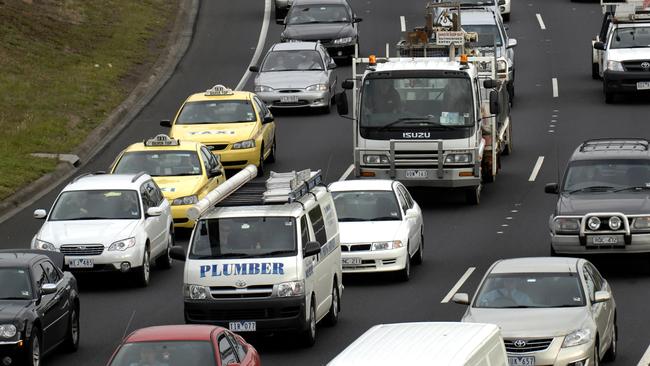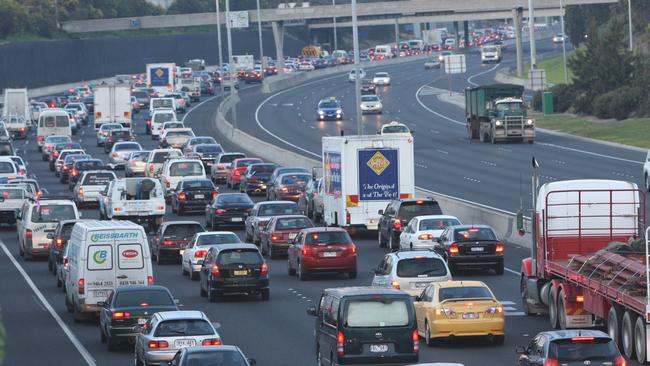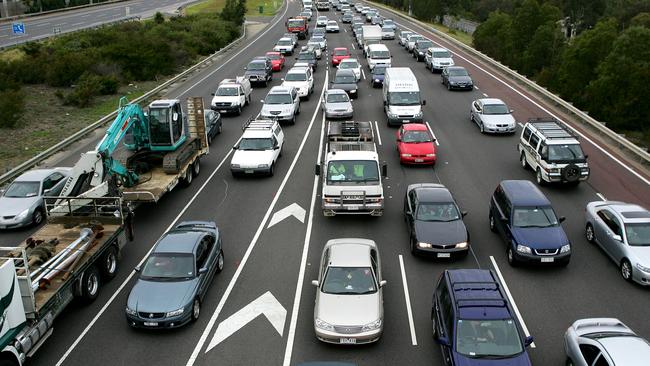Melburnians face the slowest commute in Australia
MELBURNIANS are driving slower than anywhere else in the country, with average speeds plummeting across the city. See how much slower your commute has got.
VIC News
Don't miss out on the headlines from VIC News. Followed categories will be added to My News.
MOTORISTS in Melbourne are driving slower than anywhere else in the country, with traffic chaos gripping the city and suburbs.
A report reveals average speeds are plummeting faster across the city than anywhere in Australia.
Since 2013, the average annual speed for drivers in the city has dropped from 65.3kmh to 59.9kmh, according to the Australian Automobile Association’s first annual congestion report.
MORE NEWS: WHY TEACHERS NEED TO BE MORE TECH-SAVVY
INMATES DISH OUT BRUTAL JUSTICE
CLAIMS DISABLED TEEN ‘SOLD TO SEX PREDATORS’
No other capital city in the country recorded such a sharp decline, with much of the crawl taking place over the past two years.
Nationally, more people are driving below the speed limit in Melbourne than any other city, and it was the most congested to drive in.

With the Victorian election just over a month away, traffic congestion is shaping as a key battleground for votes.
Opposition Leader Matthew Guy has vowed to resurrect the East West Link, which was dumped by the Andrews Government, and to also build the North East Link.
But Premier Daniel Andrews has only committed to the North East Link, maintaining the East West Link was a dud route.
The report revealed the biggest increase to travel times over the past five years was between Dandenong and the CBD, with 3.7 minutes added to each trip.
Ormond to the CBD and Melbourne airport to the CBD also had an additional 3.5 minutes added, because of deteriorating roads.
Melbourne’s annual rate of speed reduction is more than twice that of Sydney, and it is the city where more motorists are forced to allow extra time for a trip.
Average speeds on the Tullamarine Freeway fell three times faster than any other city’s airport route, dropping to just 53kmh.
Those driving from Hoppers Crossing to the CBD average 53.1kmh in the morning peak, while those driving from Bulleen to the city lost 2.5 minutes and crawled at 37.3kmh in the morning peak.

The Road Congestion in Australia report used mapping and location data to measure congestion across the nation.
RACV roads and traffic manager Dave Jones said journey times in Melbourne had been steady before dropping dramatically from 2016.
“This decrease in travel speeds, peak and off-peak, coincides with a lot of transport infrastructure projects kicking off,” he said.
“It really shows the impact construction work can have on the transport system.
“It is a good thing that works are happening but the unfortunate impact is that during construction, speeds are affected.
“Authorities need to manage this by giving people alternatives, advising of changing travel times and helping them change the mode of transport as well.”

Mr Jones said one solution was to set up a control centre that pulled together all information across the city’s entire transport network.
“The expansion of the city to middle and outer suburban areas means there are more people moving around but not necessarily all to the CBD,” he said.
“The clear message for government is they need to keep working hard to reduce the impact these changes have on people.”
Australian Automobile Association chief executive Michael Bradley said everyone paid the price for the congestion.
“If we are to develop effective solutions, we first need a strong understanding of the problem and how and where it’s changing,” Mr Bradley said.
“This report confirms what most people living in our major cities know all too well.
“But we hope it also helps stimulate discussion and problem-solving so that Australia can develop smart measures to address our worsening congestion.”
In 2015, transport congestion was estimated to have cost the Australian economy as much as $16.5 billion.
How travel times have changed from January 1 2013 to June 30 this year
AIRPORT-CBD
3.5 minutes longer
AM peak 2018: 51.1kmh
EPPING-CBD
2.9 minutes longer
58.8kmh AM peak
KEW-PARKVILLE
1.5 minutes longer
35.5kmh AM peak
RAVENHALL-CBD
1.1 minutes longer
55.0kmh AM peak
OROMOND-CBD
3.5 minutes longer
43.9kmh AM peak
HOPPERS CROSSING-CBD
1.0 minutes longer
53.1kmh AM peak
BUNDOORA-NUNAWADING
1.7 minutes longer
53.3kmh AM Peak 2018
BULLEEN-CBD
2.5 minutes longer
37.3kmh AM peak
DANDENONG-CBD
3.7 minutes longer
56.0kmh AM peak

Lord Mayor’s plan to tackle population growth
LORD Mayor Sally Capp wants a special deal between Melbourne City Council and the state government to better plan infrastructure projects amid rapid population growth.
The Lord Mayor said the city’s liveability was under stress with the population set to increase from 5 million to 8 million over the next 30 years.
“Already, we feel the growing pains — crowded trams, trains, roads and footpaths, homelessness and housing shortages, long travel times from outer suburbs, a heavy load on our services,” she told the Melbourne Institute Outlook Conference.
“All of this will be an increasing drag on our productivity and consequently, on regional and national prosperity.”
Cr Capp, a former head of the state Property Council, called for an accord between the city council and the state government to “help us define a common vision and speak with a united voice on projects and priorities”.
“A united plan and voice would assist targeting of state and federal funding and private sector investment,” she said.
Cr Capp welcomed Labor’s Metro Tunnel project, but said the mooted Metro 2 — an underground rail line between Clifton Hill and Newport via the CBD — was a big priority to ensure the Fishermans Bend development would be successful.


